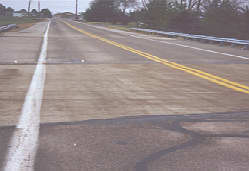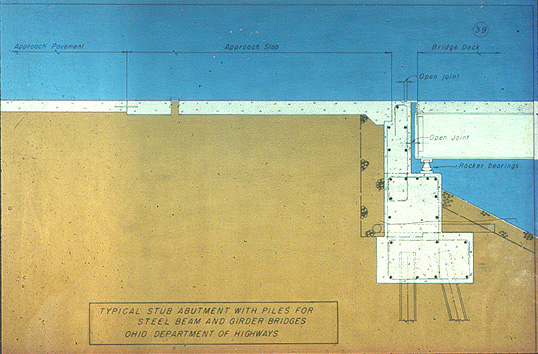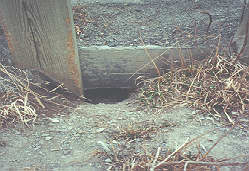

Diagram showing approach slab
in relation to roadway pavement
and
abutment backwall.
APPROACH SLABS
| The approach slab provides a transition between roadway pavement and the bridge. The approach slab acts as an intermediate bridge to span the portion of embankment directly behind the abutment/backwall which was excavated to construct the abutment/backwall. This area is difficult to compact after construction of the abutment/backwall and is prone to settlement. The approach slab bridges the gap between the rigid abutment and the undisturbed embankment beyond the area excavated. On completely new roadways (new alignments), there may not be an area of embankment that will not settle somewhat even with optimum compaction; thus the pavement end of the approach slab may still settle, creating an uneven transition onto the bridge. Settled approach slabs, if left uncorrected, cause undue impact upon the bridge, especially from trucks. It is therefore important to keep the approaches to the bridge as smooth as possible. |

Diagram showing approach slab |
Another common problem with approach slabs up until the early 1980s was the connection to the backwalls. The approach slab rests in a notch (usually a 6-inch ledge) on the back of the backwall. Quite often this ledge would shear off, allowing the approach slab to drop down directly behind the backwalls. This condition was very difficult to repair without complete reconstruction of the backwall and the approach slab. One very effective method of raising settled approach slabs without complete reconstruction is called mudjacking. This involves drilling holes through the approach slab and injecting a grout. Another method recently introduced into the market is the use of expanding urethane foams.
Both are effective ways of raising approach slabs and will be discussed in the Repair section of this Manual. Since the early 1980s, the approach slabs are now tied to the backwalls with an array of reinforcing bars which will not allow the slabs to break away from the backwalls. In any case, it is important to remember that approach slabs are designed to bridge over material that is prone to settlement. Most existing slabs have voids under them so it is important to watch for signs of settlement. One sign of possible problems is the existence of groundhog excavations under the edges of approach slabs. These should be filled or covered up with rock as necessary.
It is unlikely that approach slabs will fail structurally because of their thickness (typically 15-inches) and the large amount of reinforcing steel in the bottom. The surface may spall or scale like a bridge deck; in these cases, recommended repairs are similar to those for bridge decks.
Preventive Maintenance Recommendations:
